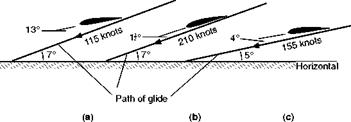Real and apparent angles of glide
Tet us remember once again that gliding must be considered as relative to the air. To an observer on the ground an aeroplane gliding into the wind may appear to remain still or, in some cases, even to ascend. In such instances there must be a wind blowing which has both a horizontal and an upward velocity, and to an observer travelling on this wind in a balloon the aeroplane would appear to be travelling forwards and descending. When viewed from the ground an aeroplane gliding against the wind will appear to glide more steeply, and will, in fact, glide more steeply relative to the ground (Fig. 6.4); and when gliding with the wind it will glide less steeply than the real angle measured relative to the air – the angle as it would appear to an observer in a free balloon.
|
Fig. 6.2 How the angle of attack affects the gliding angle |
(a) Slow glide at slope of 1 in 8 (7°). Angle of attack 13°. Speed 115 knots.
(b) Fast glide at slope of 1 in 8 (7°). Angle of attack 1 f°. Speed 210 knots.
(c) Flattest glide at slope of 1 in 12 (5°). Angle of attack 4°. Speed 155 knots.
Note. In the diagram the gliding angles, and the differences between them, have been exaggerated so as to bring out the principles.
Angle of attack
Fig 6.3 Lift/drag curve and gliding angles of aeroplane
![]()
 |
v
Fig 6.4 Effect of wind on angle of glide relative to the earth












